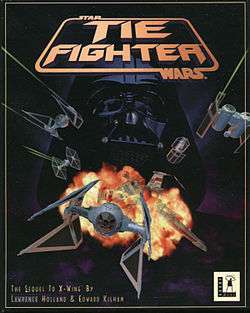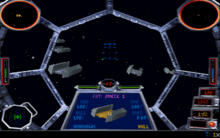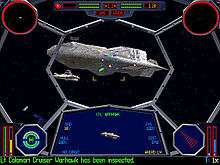Star Wars: TIE Fighter
| Star Wars: TIE Fighter | |
|---|---|
 | |
| Developer(s) | Totally Games |
| Publisher(s) | LucasArts, Disney Interactive (since 2012) |
| Designer(s) |
Lawrence Holland Edward Kilham |
| Platform(s) | DOS, Macintosh, Microsoft Windows, Linux |
| Release date(s) | July 1994 |
| Genre(s) | Space simulation |
| Mode(s) | Single-player |
Star Wars: TIE Fighter is a 1994 space flight simulator and space combat video game, the sequel to Star Wars: X-Wing. It places the player in the role of an Imperial starfighter pilot during events that occur between The Empire Strikes Back and Return of the Jedi.
Lawrence Holland and Edward Kilham's Totally Games studio, which released X-Wing the year before, designed TIE Fighter. Based on X-Wing's game engine, TIE Fighter supports Gouraud shading and adds gameplay features and craft not available in X-Wing. TIE Fighter was updated and re-released several times, and it was a critical success.
Plot
The game's plot begins soon after the Empire's victory on Hoth in The Empire Strikes Back. As with X-Wing, the player's character is unnamed in the game; however, an included novella and Prima Publishing's strategy guide name the character Maarek Stele and provide a background narrative. In addition to fighting Rebel Alliance forces, the player flies against pirates, combatants in a civil war, and traitorous Imperial forces. The original game ends with the player preventing a coup against Emperor Palpatine and being personally rewarded during a large ceremony. Subsequent expansions focus on Admiral Thrawn's efforts to stop an Imperial traitor; the final mission of the second expansion concludes just before the climactic battle at the end of Return of the Jedi. Though playing on the side of the Star Wars saga's villain, the game presents Imperial forces as maintainers of peace and order in a tumultuous galaxy.
The storyline is divided across several battles, each of which has four to eight missions. Although some of the battles can be played out of order, individual missions within each battle are played linearly. Mission briefings and debriefings, cutscenes, and in-flight communication advance the story.
Gameplay
After selecting a pilot file, the player views the "concourse", a hub with doors to different features of the game. While the main focus of gameplay is completing battles, the concourse also offers several other areas. The training simulator lets the player fly each of the pilotable Imperial craft through a complex obstacle course. The combat chamber offers four extra missions for each craft, ranging from training scenarios to historical reenactments of important missions. There is also a room to view mission recordings, and a tech room to view information about every spacecraft that appears in the game.[1] When the player selects a mission, he or she is given a briefing, consisting of a dialog describing the mission and an animated map illustrating vessel positions and basic flight patterns. The player may optionally read a list questions and answers about the mission.[1]
In addition to the standard mission briefing covering primary objectives, there is often another briefing given by a mysterious figure who belongs to the Emperor's Inner Circle. This person informs the pilot of optional secondary objectives and provides additional plot information. Completing the primary objectives allows the player to progress to the next mission and earn Imperial military promotion; completing secondary and secret objectives garners additional medals and promotions within the inner circle.[2]
Combat

In-flight gameplay is similar to X-Wing, played primarily in first-person but with the option to switch to third person. All flight takes place in space; the player does not encounter gravity or atmospheric effects. Mission roles including dogfighting, escorting or disabling other craft, inspecting vehicles, and attacking capital ships and space stations. Initial missions place the player in unshielded TIE fighter variants; as the game progresses, the player gains access to advanced fighters with shields and better armaments.[3]
Laser cannons and ion cannons serve as short range weapons, damaging or disabling targets respectively. Some starfighters carry limited warheads for additional range/firepower. As with X-Wing, the player needs to balance power allocation between weapons, engines, and shields (when available); some craft also require the player to further balance power for a beam weapon. The player can also change the firing modes of his or her fighter's weapons (for example, having a pair of laser cannons fire together or alternately). If the ship possesses shields, the player chooses the shield balance between front and rear.
Shields are rechargeable; they protect from damage but are depleted when absorbing damage. When the player's craft is unshielded, enemy fire will damage the player's hull. Hull damage can disable systems, such as the engines or targeting computer. Disabled systems will slowly be repaired; TIE Fighter allows the player to choose the order in which systems are repaired. Hull damage may also cause cockpit displays to break, rendering them useless for the remainder of the mission. Heavy hull damage will destroy the player's spacecraft. When the player's craft is destroyed before completing a mission, or the mission is otherwise a failure, the player can attempt the mission again. However, the mission is still successful if the player's craft is destroyed after all primary mission objectives are completed.
Despite the similarities to X-Wing, TIE Fighter does introduce several gameplay changes. The targeting system allows players to target capital ships' and space stations' components, such as shield generators and weapons. Additionally, the targeting display shows a 3D model and relative orientation of the player's target. Mission objective status is accessible in-game, as is a log of in-flight messages.
Music
The music for Star Wars: TIE Fighter was composed by Clint Bajakian and contains many of John Williams' themes from the original trilogy. However, many motifs (such as "The Imperial March" motifs) which were originally composed as dark motifs are used as heroic motifs. This is consistent with the theme of the game, where the player plays as an Imperial TIE Fighter pilot.
The in-game music played during flight sequences (missions) uses the iMuse game engine. This uses leitmotifs to vary the music played during missions depending on the actions of the player or other mission events. For example, a special motif is played when player achieves a victory, when the mission is failed, when secondary or bonus goals or completed, when an Imperial or Rebel capital ship exits hyperspace etc. This does mirror the use of leitmotifs in the original film music while at the same time makes the music sequence a little different with each mission.
Release

LucasArts offered a pre-release demo on two floppy disks bundled with Computer Gaming World. The single-mission demo, sponsored by Dodge and featuring an ad for the Dodge Neon, advertises a spring 1994 TIE Fighter release. However, TIE Fighter was not released until July 1994, 17 months after X-Wing's debut. The Defender of the Empire expansion, which adds three battles, came out soon thereafter. Later that year, LucasArts released a Collector’s CD-ROM version of X-Wing using TIE Fighter's updated graphics engine.
In 1995, TIE Fighter also received a Collector's CD-ROM. The CD-ROM version offered optional enhanced SVGA graphics, increasing the game's resolution from 320x200 to 640x480.[2] The cinematic cutscenes were also enhanced, and the game received numerous voiceovers. The CD-ROM includes the previously released Defender of the Empire expansion and an additional Enemies of the Empire expansion. This CD-ROM also added support for gameplay under Mac OS 8 and Mac OS 9.
TIE Fighter is part of the 1998 X-Wing Collector Series, which also includes updated versions of X-Wing and a pared-down version of X-Wing vs. TIE Fighter. This version drops DOS support, installing only under Windows 9x. TIE Fighter and X-Wing use the X-Wing vs. TIE Fighter flight engine, which adds 3D-accelerated graphics and texture mapping. The MIDI-based interactive soundtrack used in previous versions is replaced by looped Red Book audio recordings of John Williams' Star Wars score.[2] This version also requires a joystick; previously, players could use a mouse and keyboard. This version was later bundled with the X-Wing Trilogy, which includes X-Wing and X-Wing Alliance.
On October 28, 2014, TIE Fighter along with X-Wing were released digitally for the first time on GOG.com. Both the original DOS and Windows editions were included, with updates to run on modern PCs.[4]
Reception
| Reception | ||||||||||||||||||
|---|---|---|---|---|---|---|---|---|---|---|---|---|---|---|---|---|---|---|
| ||||||||||||||||||
| ||||||||||||||||||
Gamebytes Magazine gave the original release its "very highest recommendation", citing numerous improvements over X-Wing. The reviewer called the graphics "astonishing" and noted improved artificial intelligence and in-flight information systems. The review's "single complaint" was the lackluster ending.[1] Edge praised many of the graphic and gameplay enhancements and new features over X-Wing, but described the missions as repetitive and complained the game loses appeal when the player isn't fighting for the underdog Rebellion.[3] GameSpot's review of the Collector's CD-ROM Edition called TIE Fighter "the best space combat game ever made" and praised the updated graphics.[6]
Awards and legacy
Strategy Plus awarded the game "Best Game of the Year".[5] TIE Fighter became the second Lawrence Holland game to be inducted into Computer Gaming World's "Hall of Fame"[7] and was inducted into GameSpot's "Greatest Games of All Time" in July 2004[8] and IGN's "Hall of Fame" in 2007.[10]
PC Gamer ranked the Collector's CD-ROM Edition #1 in its "Top 50 Greatest Games of All Time" list in May 1997.[12] It was ranked #3 on IGN's list of the top 25 PC games of all time in 2007 and #2 in 2009.[9][11] The game was recognized again by IGN in 2010 when it was named the "best Star Wars game ever made".[13]
Maarek Stele from the Prima Publishing strategy guide later appears as a TIE Advanced [14] and TIE Defender [15] pilot in the Star Wars: X-Wing miniatures game produced by Fantasy Flight Games.
See also
References
- 1 2 3 Sandler, Phil (1994). "TIE FIGHTER from LucasArts".
- 1 2 3 "GameSpot Presents The Greatest Games Of All Time". GameSpot. CBS Interactive. Archived from the original on April 24, 2006.
- 1 2 "TIE Fighter Review". Edge. Matthew Pierce. July 28, 1994. Archived from the original on June 18, 2014.
- ↑ "New Publisher: Disney Interactive / Lucasfilm - GOG.com". October 28, 2014. Retrieved October 28, 2014.
- 1 2 3 "Fact Sheet". Totally Games.
- 1 2 McDonald, T. Liam (May 1, 1996). "Star Wars TIE Fighter: Collector's CD-ROM Review". GameSpot. CBS Interactive. Archived from the original on October 7, 2013.
- 1 2 "CGW's Hall of Fame". 1UP.com. Retrieved November 17, 2010.
- 1 2 "The Greatest Games of all Time". Archived from the original on August 19, 2006. Retrieved November 17, 2010.
- 1 2 Adams, Dan; Butts, Steve; Onyett, Charles (March 16, 2007). "Top 25 PC Games of All Time". IGN. Retrieved March 20, 2009.
- 1 2 "IGN Videogame Hall Of Fame: Star Wars: TIE Fighter". IGN. 2007. Retrieved November 17, 2010.
- 1 2 "Top 25 PC Games of All Time". IGN. August 6, 2009. Archived from the original on August 9, 2009. Retrieved July 22, 2016.
- 1 2 "PC Gamer". May 1997.
- ↑ "Best Star Wars Games Ever Made". IGN. J2 Global. May 20, 2010.
- ↑ Elite Pilots and Advanced Tactics: Preview the Upcoming TIE Advanced Expansion Pack for X-Wing by Fantasy Flight Games
- ↑ Defend the Empire: A Preview of the Imperial Veterans Expansion Pack for X-Wing by Fantasy Flight Games
External links
- Star Wars: TIE Fighter on Wookieepedia, a Star Wars wiki
- Star Wars: TIE Fighter at MobyGames